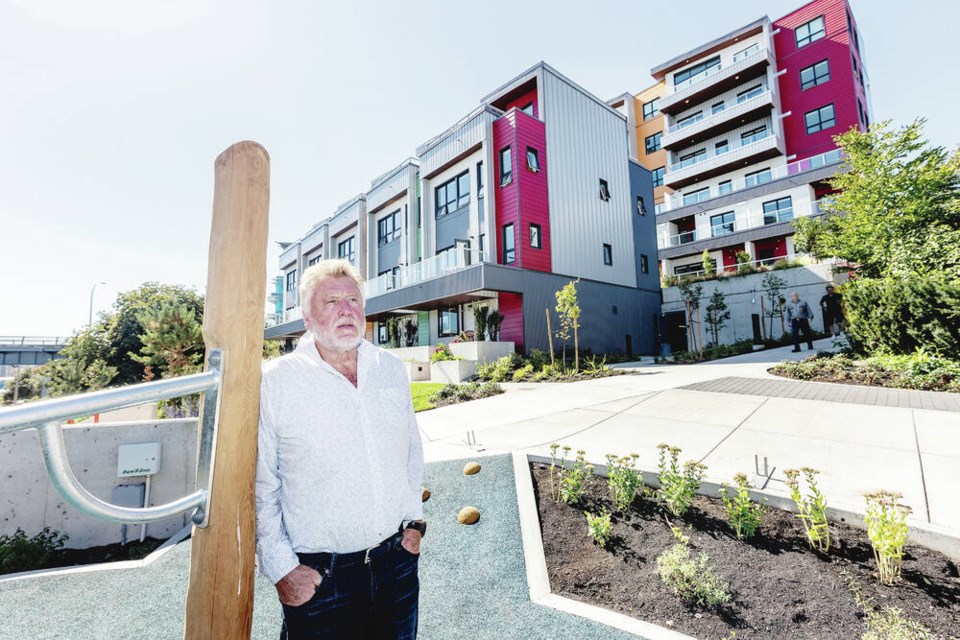The Railyards’ colourful playground with a splash area is the newest and final piece in the site’s 21-year build-out where residential buildings have been constructed on top of what was once a bleak former industrial site in Vic West.
When developer Chris Le Fevre first walked the 13-acre property it was a “wasteland.” The former CN railyard had been remediated but left undeveloped until Le Fevre bought it for just over $3 million.
Today, close to 500 condominiums and townhouses have become homes to about 1,500 people. Le Fevre said he has spent nearly $400 million. Of that, more than $10 million went on amenities. About 30 per cent of the homes are townhouses and the rest are condos.
Amenities include the Galloping Goose trail running along the waterfront, as well as parkettes such as Regatta Point park and launch pier, public washrooms, a boardwalk, plaza and public parking areas.
Life at The Railyards, by Bay Street and Tyee Road, brings residents within walking distance of Victoria’s downtown. It’s a generally quiet area despite busy streets nearby. The waterway is used by many residents, evident by the kayaks and paddleboards hanging outside a number of units.
Quinn Radford walked Harold, his labrador-Doberman mix, along a tree-shaded sidewalk this week, saying he has lived in a condo at the Railyards for a year. It was a warm day, but a breeze from the water cooled the street.
“It’s great. So many places to walk,” said Radford.
Shopping and services are close by at the corner of Tyee Road and Bay Street.
Cole Hartley has lived at the Railyards for about a year and calls the quiet neighbourhood “‘lovely.”
“The proximity to downtown is nice. I love the greenery.”
He works remotely and enjoys walking and cycling. “Being on the Goose is just great.”
Le Fevre can look back at development on a large brownfield site.
“The first day I walked on this property with the listing agents I had an image in my own mind of what I could do with this property and I’ve carried through with the original [idea].”
Le Fevre, a prolific developer elsewhere in Canada and the U.S., is known locally for his work in Old Town Victoria, where he has converted old buildings into housing and upgraded them for commercial use.
As Victoria has expanded, other former industrial sites have been converted into new uses. These include the Selkirk Waterfront with offices, condominiums, park space, commercial uses and a school. The Railyards’ mixed-use neighbour Dockside Green is still being built out and the Songhees lands were home to industry at one time.
Le Fevre recalls there were no roads and no services on the property. “We’ve had to introduce all the roadways, which have subsequently been dedicated to the city.
“There were a few rugged cyclists who were finding their way along the foreshore.”
At that time, he estimates fewer than 20 cyclists per day found their way across the property. Today, “I’d put that number in the thousands.”
Le Fevre won rezoning at Victoria City Hall, where a master development agreement governed development rules for the site and has not been altered over the years.
The project has delivered contemporary-style buildings with highlights of bright colours and an industrial vibe to create a vibrant community.
“Even though I’m a heritage developer, I did not want for one minute to try and build faux heritage on this property,” Le Fevre said.
He put major density on Tyee Road and the lower height buildings close to the foreshore. A six-storey building, the tallest, was recently finished at Tyee Road and Bay Street.
“It’s a very very happy community,” he said. “People treasure where they live. It has created a new lifestyle for many of them.”
The overall project took longer than Le Fevre originally expected. In the past two decades, he weathered recessions but remained committed to the project.
“I’ve always been a fairly dogged, steady, middle-of-the-road guy. I never built too many units at any one moment in time, such that I could have been caught in a downdraft when the market changed.
“There were some soft times in the market and what I did then was build fewer units and survived accordingly.
“To be honest, that’s where I take a lot of pride in bringing it to the finish line because we stayed the course.”
Le Fevre said he has visited the Railyards just about every day for two years. “I’ve been very privileged to build this from start to finish. I’m going to miss it.
“I come here and look at people walking on the Goose or in the parks and enjoying life. That feels pretty good.”
>>> To comment on this article, write a letter to the editor: [email protected]



